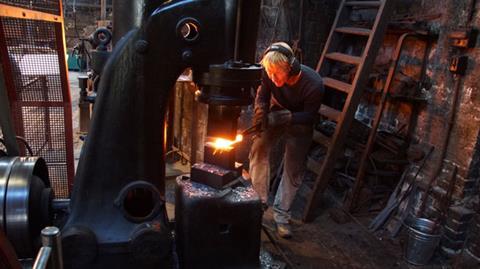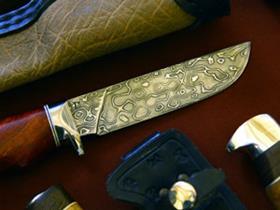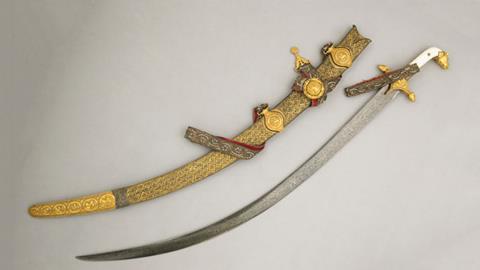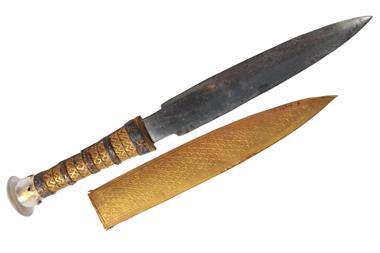The skills behind the legendary sharpness of wootz steel were once forgotten, but Andy Extance talks to the researchers unsheathing its secrets
From beside his computer David Edge picks up something that marks his office as unique: a 19th century Afghan wootz steel dagger. Its chaotic, swirling patterns are striking as the blade is tilted. Although Edge is head of conservation at the Wallace Collection in London, UK, which has many exotic knives and swords, he personally owns this dagger. The patterns’ similarity to the rings that oil forms on the surface of water makes it obvious why the alloy is sometimes called watered steel.
When western Europeans encountered these weapons during crusades against the Islamic world in the 11th–13th centuries they called them Damascus steel. ‘It’s completely different to what Europe was doing,’ explains Edge. ‘They were streets ahead in metallurgical processes.’ The name encompassed two similar-looking material types, produced differently. Pattern-welded Damascus blades were made by joining alternating stronger and weaker steel sheets. While attractive, these often-brittle blades are overshadowed by others made from a steel Europeans called wootz.
Had Saladin been armed with a wootz-bladed sword, it might have been twice as hard as one wielded by his crusader nemesis Richard the Lionheart, notes Wallace Collection archaeometallurgist Alan Williams. As well as beauty and improved robustness, wootz blades were legendary for their enduring sharpness, enabling fabled abilities such as cleanly slicing silk scarves dropped on them. Typically all Indo-Persian rulers had wootz blades, adds Edge. For example, a wootz sword that reputedly belonged to Ranjit Singh, founder of the Sikh empire in the Punjab, is in the Wallace Collection.
Yet the last wootz blades with the highest-quality Damascene patterns were produced around 1750. In 1985, an international meeting of experts in New York agreed that the final low-quality patterned blades were probably made in the early 19th century.1 After that, key production secrets were forgotten. But over recent decades, scientists and metalworkers have mounted their own crusade to resolve the mysteries behind this lost technology.
Cutting edge
Wootz steel was a commodity material imported by the Islamic world to make weapons, explains Gill Juleff, an archaeometallurgist at the University of Exeter, UK. Its properties drove medieval trade from places like Sri Lanka and the Telangana region of India, both locations where Juleff has studied steel production. She holds a crucible used to make the prized steel. Produced from materials including clay and rice husks, it resembles a tall, roughly moulded beaker, but where it’s been cut in two its neatly cylindrical interior is obvious. It would originally have had a lid like a pepper pot, Juleff explains.
This steel refining process is bordering on alchemy – which is perhaps one way legends come up about it
Dating from the early 20th century, this is one of the last crucibles used in Sri Lanka. Yet it’s hard for the untrained eye to distinguish it from the next one Juleff picks up, from the 7th century. There’s tenuous evidence that crucible steel production started as far back as the first millennium BC, she adds. ‘It was also made in Turkmenistan, Uzbekistan and even Iran. If you go where it was made, you’ll find broken crucibles by the hundreds of thousands.’
These remarkably durable little crucibles contrast greatly with larger-scale iron production processes used at the same time. Iron enclosed in crucibles and heated by lots of charcoal melted, incorporating carbon needed to make steel from charcoal and leaves that historical descriptions suggest were added.2 ‘Slag’ impurities could float out of the molten mixture, something other steel production processes struggled to achieve.
‘This refining process takes iron and produces small steel ingots,’ Juleff says. ‘Technologically it doesn’t sit easily within the normal iron repertoire. It’s bordering on alchemy – which is perhaps one way legends come up about it.’ Not all the crucible steel produced in this way would have the attractive watery surface pattern, she adds, making its creation the most mysterious process of all.
Imperial clampdown
Today, roadside blacksmiths still work in Telangana, the descendants of artisans responsible for creating the legendary metalwork. Juleff surveyed the region in 2010 with her colleagues, and of them, ‘Jai’ Jaikishan, is a historian working at BNS College in Hyderabad, India. He explains that Telangana produced lots of crucible steel in the 16th–18th century. ‘Wootz producers in this region were called Kammari. Their technical expertise was much in demand for making war equipment, but at present village smiths are not handling wootz steel.’
Jaikishan blames the loss of wootz knowledge on the British East India Company’s response to the Indian Rebellion, or First War of Independence, which started in 1857. ‘They decided to stop the production of wootz steel in 1858,’ he says. Meanwhile, forest laws imposed in 1862 also stopped Indian communities exploiting nearby trees, cutting the supply of charcoal. ‘This broke up the iron and wootz industry in this country,’ Jaikishan says.

By this time, European chemists had identified iron’s absorption of carbon as critical in steel production, and identified carbon itself as an element, leading to large-scale steel manufacturing. Today we know that if steel is kept at temperatures below 900°C, it exists in a crystal structure known as ferrite, which contains 0.022% carbon at most. Beyond that temperature it changes to the austenite crystal form, which can accommodate up to 2.14% carbon. As it cools, the extra carbon separates into the compound cementite, Fe3C, either separately or as a layered ferrite/cementite mixture known as pearlite.
In 1924, a Swiss scientist, B Zschokke, identified wootz Damascus steel as a pearlite mixture containing around 1.5% carbon. He photographed the microscopic composition of several blades, showing bands of spherical, white cementite particles that form the watery pattern. The bands also contribute to Damascus swords’ legendary sharpness and toughness, notes Peter Paufler, a retired structural physicist formerly at the Technical University of Dresden, Germany. By itself cementite is hard, which is ideal for forming a sharp edge, but brittle. However, thin cementite plates avoid the brittleness problem. ‘Parallel fibres of a strong material in a soft matrix increase the latter’s strength considerably,’ Paufler explains.
Beginning in 2003 Paufler’s team studied a variety of blades, including one of those examined by Zschokke, with modern optical and electron microscopy. They confirmed the attractive appearance arose from cementite particles at least tens of micrometres in diameter and also found linear nanometre-scale carbon-rich phases that potentially enhanced the blades’ sharpness. Some nanoparticles were cementite, but the German scientists concluded that other more surprising and modern-seeming structures were present, namely carbon nanotubes.3 However, the scientists were unable to get the funding needed to confirm their hypothesis for how the nanotubes formed. And other scientists, such as Williams and Edge, are sceptical that they are really found in wootz steel at all.
On the trail of steel pine trees

To make a strong, good-looking blade requires smiths to physically beat particles into position with a hammer during forging. Virtually all high-carbon steels have bands of dark pearlite material in silvery ferrite, providing the steel has been heavily deformed followed by slow cooling from austenite. In watered Damascus steel blades, records indicate that the pattern was made more prominent by etching with a weak acid, such as fruit juice. Ancient pictures also show women doing the deformation, says Paufler, suggesting endurance was important. ‘There are reports that for one blade, one week’s time of forging/cooling/heating cycles was needed,’ he says. ‘I have great admiration for the expertise of ancient blacksmiths. They had to control chemical composition, temperature and deformation rate without modern measuring instruments.’
French steel pioneer René Antoine Ferchault de Réaumur showed the importance of such smithing know-how. After acquiring samples of Indian steel, a fellow 18th century chemist writes, Réaumur ‘found no-one in Paris who could forge it; whereupon he laid the blame on our workmen, since the inhabitants of the east know how to work that kind of steel’.4 But if this were the only secret, surely the Kammari should have retained the knowledge?
In the early 1980s, John Verhoeven of Iowa State University in the US started hunting secrets that eluded even the Kammari. Verhoeven and colleagues worked steel to produce standard ferrite/pearlite banding, using an automated rolling mill and with a smith forging a blade. Both failed to produce watery patterns. Through other Damascus steel enthusiasts, Verhoeven met Alfred Pendray, a Florida-based blacksmith, who worked his steel for dozens more cycles than the Iowa scientist. ‘He sent me stuff intriguingly close to what we were after, but wasn’t able to reproduce it very well,’ Verhoeven recalls.
After ten years, Pendray and Verhoeven were able to make authentic Damascus patterns regularly using a cast iron called Sorel. They were able to determine why by analysing the iron’s composition more precisely than previously thought necessary. Sorel was very pure, but they found it contained around 0.04% of vanadium. Levels down to 40 parts per million would form the Damascus pattern, they discovered, and medieval blades – including those Zschokke studied – almost always contained more vanadium than this.5
Vanadium and other impurities like chromium and titanium encourage the formation of hard cementite particles, positioned by the shapes steel forms as it solidifies. ‘If you were able to look through the surface of a solidifying metal alloy liquid and see the solid it would look like a pine forest from an airplane,’ Verhoeven explains. ‘Solid dendrites have branches coming off at right angles from their main stalk, like a tree.’ As the solid forms, the growing dendrites push vanadium impurities out into the surrounding liquid. ‘That causes the vanadium to line up, which in turn causes the carbides to line up in planes.’
This woody analogy potentially answers the question that left researchers stumped: Why did wootz Damascus blades suddenly disappear? Producers may have used up or become unable to access iron ores containing vanadium or other similar impurities that they relied upon, Verhoeven and Pendray suggest.
Dispelling fantasy
The veteran steel experts continue to use this knowledge, though Pendray says he makes less than 20 blades a year. ‘I hardly even recoup my expense, because it’s so labour-intensive and you use a lot of materials and fuel,’ he explains. Much of his work remains experimental as he tries to improve the appearance still further, for example, by increasing the spacing between cementite bands. ‘The best old stuff runs 60–70µm between layers. The visual pattern is better with a broader spacing – you can see it from just about across the room. Recently I’ve been able to go over 100µm.’
Damascus steel’s fantastic reputation of being better than modern steel is wrong, but wootz steel was better than anything else they had before the 1800s
Though Pendray doesn’t guarantee his blades are the same as medieval ones, all the evidence he has matches up, and he’s also convinced other discerning experts. For example, he’s working with smiths from King Abdullah II of Jordan to make watered wootz steel. ‘They walked in the shop,’ Pendray recalls, ‘and I had knives finished laid out, and they said, “We need to find out how you do it”.’
In Pendray and Verhoeven’s own ‘scarf drop’ test, wootz blades apparently cut silk as cleanly as scissors, while modern blade cuts’ edges were more roughly torn. Yet Verhoeven downplays the test as unreliable and unscientific, and says Damascus steel’s fantastic reputation of being better than modern steel is ‘completely wrong’. ‘Zschokke showed that contemporary German steel blades were less brittle and just as hard on the edge,’ he stresses. ‘But wootz steel was better than anything else they had before the 1800s usually.’
Though these methods for making wootz steel are successful, historically there were probably many variations that remain to be explored, says Williams. He’s excited, because he and Edge are using a technique that might reveal such variations. And unlike previously-used approaches, it causes no physical damage, meaning it can safely study even precious historical artefacts.
Forensic neutrons
The method involves irradiating blades with neutrons in the INES diffractometer at the Isis facility in Oxfordshire, UK.6 Whereas x-rays only provide information from blade surfaces, neutrons penetrate more deeply, explains instrument scientist Antonella Scherillo. ‘Most neutrons pass through undisturbed, but the ones that interact give useful information.’ The peaks obtained identify steel phases such as ferrite or cementite, adds Francesco Grazzi from the Institute of Complex Systems in Sesto Fiorentino, Italy. ‘The phase amount gives you the carbon content,’ he says.
The Wallace Collection’s primary application is solving a puzzle many of its weapons pose. Down the centuries they were polished with abrasive materials like brick dust, leaving a uniform-looking layer of strained atoms. This is the case with the dagger of Taj Mahal builder Shah Jahan, whose solid gold, emerald, diamond and ruby-encrusted hilt would have suited a watered steel blade. ‘We’ve no idea whether it was crucible steel,’ says Edge. ‘And no-one’s going to let us cut bits off to find out.’
Non-destructive neutron diffraction first reveals carbon content, identifying high quality oriental blades, Williams explains. Then, rotating wootz steel objects will usually give different diffraction patterns, thanks to their irregular cementite bands. If the evidence suggests blades were originally watered steel, they’re treated with weak etchant like iron(III) chloride to restore the decoration.
Yet these studies have raised a further puzzle, as some blades likely to be wootz show the same diffraction pattern in all directions. ‘We think it’s to do with forging temperature,’ says Williams. ‘We’re going to do more experiments in 2016 and if this is the case, we can tell what went on in the workshop where they were made.’
If these suspicions are borne out, wootz steel’s remarkable story will enter another exciting new chapter. The data would expand the treasure trove of evidence for how to make this prestigious material, wrested from the brink of obscurity by modern techniques applied by a determined and ingenious few.
Andy Extance is a science writer based in Exeter, UK
References
1 J D Verhoeven, Indian J. Hist. Sci., 2007, 42, 559
2 C Schwarz, Stahl u. Eisen, 1901, 21, 209
3 M Reibold et al, Nature, 2006, 444, 286 (DOI: 10.1038/444286a)
4 M Breant, J. Franklin Inst., 1824, 8, 267 (DOI: 10.1016/s0016-0032(26)91821-8)
5 J D Verhoeven et al, J. Miner. Metals Mater. Soc., 1998, 50, 58 (DOI: 10.1007/s11837-998-0419-y)
6 E Barzagli et al, Appl. Phys. A, 2015, 119, 97 (DOI 10.1007/s00339-014-8968-0)













No comments yet